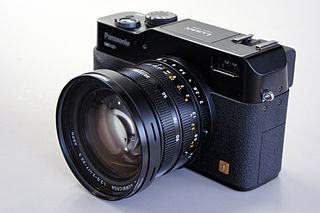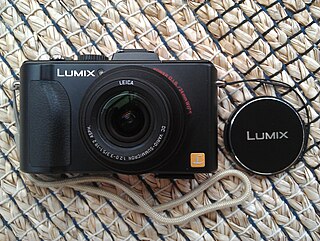
A digital single-lens reflex camera is a digital camera that combines the optics and mechanisms of a single-lens reflex camera with a solid-state image sensor and digitally records the images from the sensor.

Lumix is Panasonic's brand of digital cameras, ranging from pocket point-and-shoot models to digital SLRs.

The Lumix DMC-L1 is Panasonic's first DSLR camera, and was announced in February 2006. This camera adheres to the Four Thirds System lens mount standard, making it the first non-Olympus Four Thirds camera, and thus confirming that the Four Thirds System is a semi-open standard such that compatible camera bodies can be built by different companies.

A mirrorless camera is a digital camera which, in contrast to DSLRs, does not use a mirror in order to ensure that the image presented to the photographer through the viewfinder is identical to that taken by the camera. They have come to replace DSLRs, which have historically dominated interchangeable lens cameras. Other terms include electronic viewfinder interchangeable lens (EVIL) cameras and compact system cameras (CSCs).

The Panasonic Lumix DMC-LX5, or LX5, is a high-end compact "point and shoot" camera launched by Panasonic in 2010 to succeed the LX3.

The Panasonic Lumix DMC-LX7, or LX7, is a high-end compact "point and shoot" camera launched by Panasonic in 2012 to succeed the LX5.
Panasonic Lumix DMC-FX700 is a digital camera by Panasonic Lumix. The highest-resolution pictures it records is 14.1 megapixels, through its 24mm Ultra Wide-Angle Leica DC VARIO-SUMMICRON.
Panasonic Lumix DMC-FX77 is a digital camera by Panasonic Lumix. The highest-resolution pictures it records is 14.1 megapixels, through its 24mm Ultra Wide-Angle Leica DC VARIO-SUMMICRON.

Panasonic Lumix DMC-LF1 is a digital camera by Panasonic Lumix. The highest-resolution pictures it records is 12.1 megapixels, through its 28 mm LEICA DC VARIO-SUMMICRON.

The Panasonic Lumix DMC-FZ1000 is a digital superzoom bridge camera by Panasonic. It went on sale in June 2014. It has a 20 megapixel 3:2 BSI-CMOS sensor and Leica-branded 25–400 mm equivalent focal length lens with a maximum aperture of f/2.8 to f/4. It has a 1-inch CMOS sensor and supports ISO film speeds from 80 to 25600, shutter speeds from 1/16000 s to 60 s and RAW capture, while the lowest physical shutter speed is 1/4000 s. The unit is equipped with five "Fn" function buttons which can be allocated to custom shortcuts.

The Sony Cyber-shot DSC-RX10 is a digital superzoom bridge camera made by Sony. It was announced on October 16, 2013.

The Digilux 2 is a digital camera model sold by Leica Camera, with the body manufactured in Japan by Matsushita, which sold a variant as the Panasonic Lumix DMC-LC1. Its image sensor is a CCD with 5.24 million total pixels. It has a color, transreflective thin-film transistor liquid crystal display with 211,000 pixels, in addition to an electronic viewfinder. It has a near-focus range of 30 centimeters. The camera has a built-in flash. This flash, first of its kind, has the ability to be pointed up, as well as the standard method of pointing straight ahead, in order to "bounce" the light off a ceiling. The camera weighs 630 grams. Its dimensions are 135 millimeters in width, 82 millimeters in height, and 103 millimeters in depth. The camera is fitted with a Leica Vario Summicron lens of f/2 with a zoom function of 28mm - 90mm in 35mm format.

The Sony RX is the name of a range of fixed lens compact point-and-shoot digital cameras created by Sony in 2012. All cameras are equipped with Carl Zeiss lenses.

The Leica SL is a full-frame mirrorless interchangeable-lens camera announced by Leica Camera AG on 20 October 2015. The SL was promoted as a camera system for professional applications. Beside the Leica S-System, the Leica SL-System was the 2nd professional camera system in the company's product portfolio.

Nocticron is the brand name of Leica lenses with an extreme speed of f/1.2. Because of the large aperture size and its image stabilisation system it is possible to take images with relatively short exposure time especially in available light situations. Together with the high number of nine diaphragm blades the lens creates a strong and pleasant bokeh.

The Panasonic Leica D Vario-Elmarit 14-50mm F2.8-3.5 ASPH Mega OIS is an interchangeable camera lens announced by Panasonic on February 26, 2006. It was the first Leica lens with optical image stabilisation.

The Leica L-Mount is a bayonet mount developed by Leica Camera AG for interchangeable-lens autofocus digital cameras.

The name Summilux is used by Leica and Panasonic Lumix to designate camera lenses that have a maximum aperture brighter than f/2, typically at f/1.4, but dimmer than f/1.0. The lens has been in production since 1959 and carries on to the present day.


















